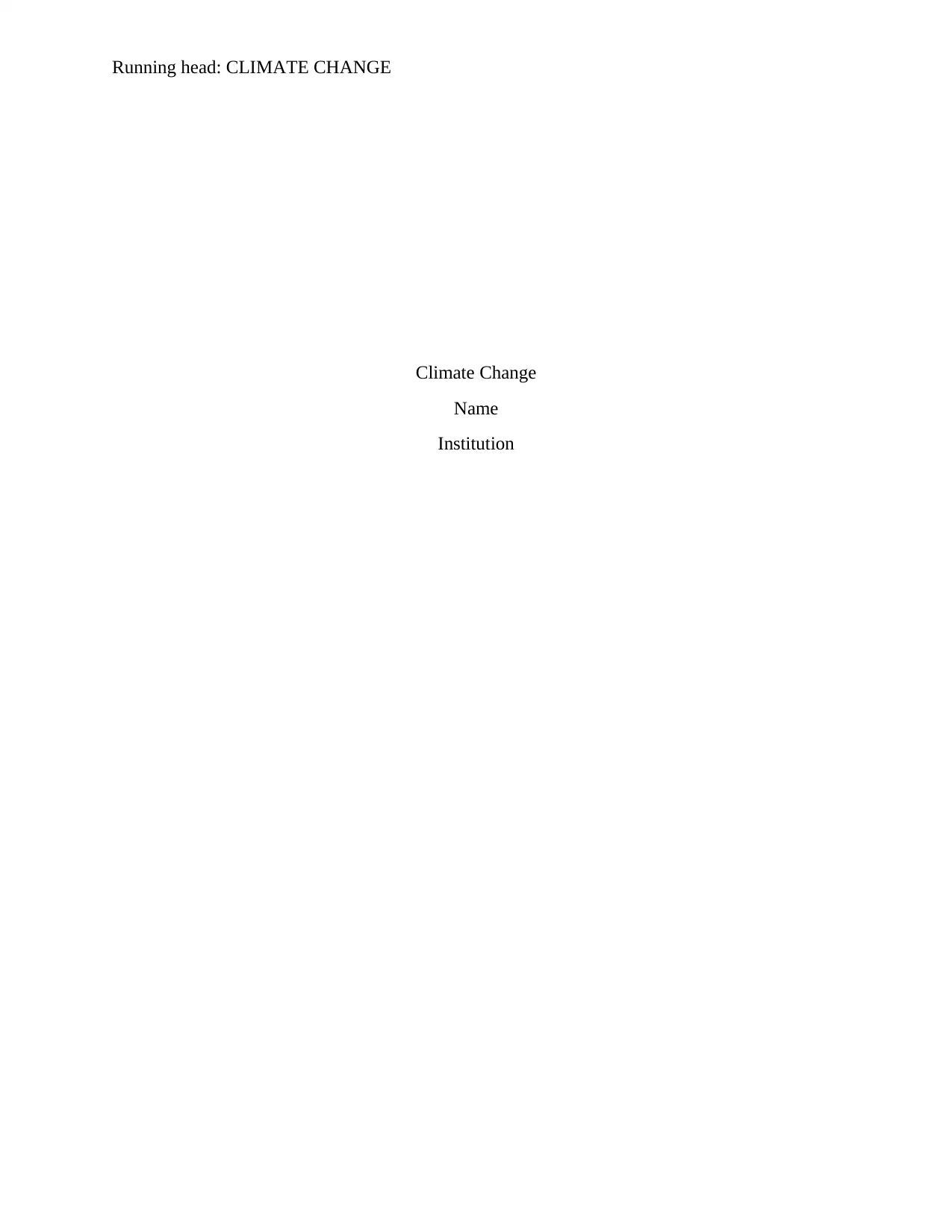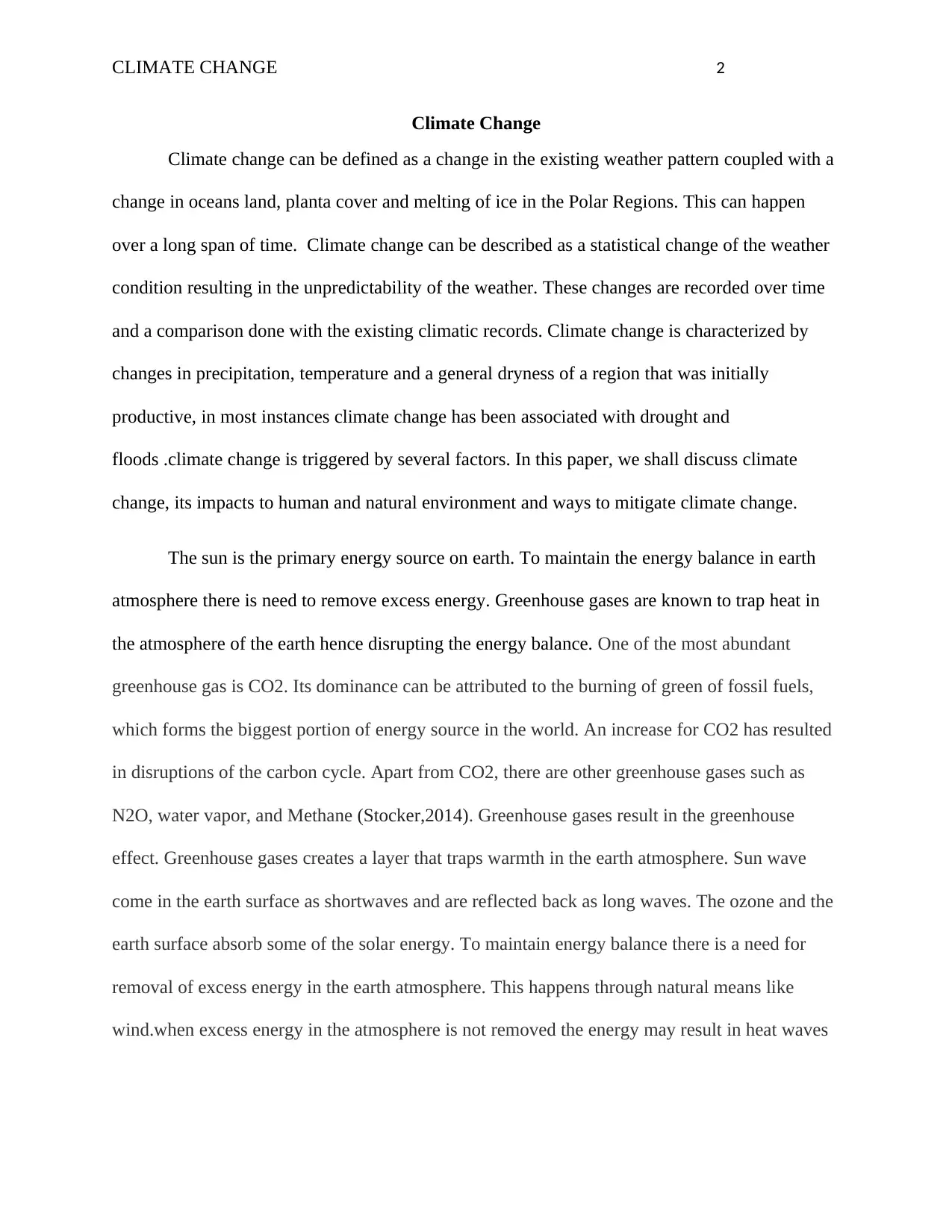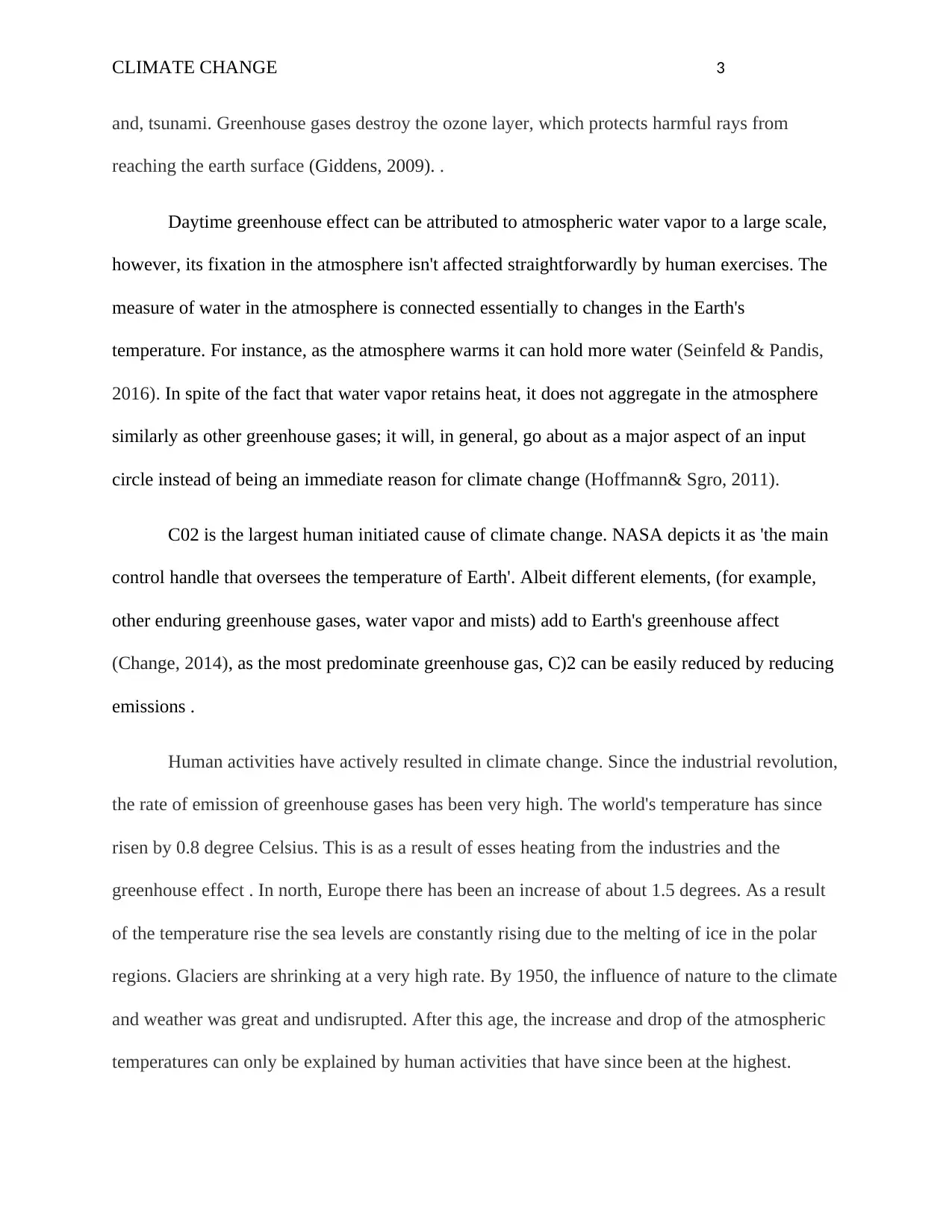Climate Change
VerifiedAdded on 2023/04/21
|6
|1496
|365
AI Summary
Climate change can be defined as a change in the existing weather pattern coupled with a change in oceans land, plant cover and melting of ice in the Polar Regions. This article discusses the impact, causes, and ways to mitigate climate change.
Contribute Materials
Your contribution can guide someone’s learning journey. Share your
documents today.

Running head: CLIMATE CHANGE
Climate Change
Name
Institution
Climate Change
Name
Institution
Secure Best Marks with AI Grader
Need help grading? Try our AI Grader for instant feedback on your assignments.

CLIMATE CHANGE 2
Climate Change
Climate change can be defined as a change in the existing weather pattern coupled with a
change in oceans land, planta cover and melting of ice in the Polar Regions. This can happen
over a long span of time. Climate change can be described as a statistical change of the weather
condition resulting in the unpredictability of the weather. These changes are recorded over time
and a comparison done with the existing climatic records. Climate change is characterized by
changes in precipitation, temperature and a general dryness of a region that was initially
productive, in most instances climate change has been associated with drought and
floods .climate change is triggered by several factors. In this paper, we shall discuss climate
change, its impacts to human and natural environment and ways to mitigate climate change.
The sun is the primary energy source on earth. To maintain the energy balance in earth
atmosphere there is need to remove excess energy. Greenhouse gases are known to trap heat in
the atmosphere of the earth hence disrupting the energy balance. One of the most abundant
greenhouse gas is CO2. Its dominance can be attributed to the burning of green of fossil fuels,
which forms the biggest portion of energy source in the world. An increase for CO2 has resulted
in disruptions of the carbon cycle. Apart from CO2, there are other greenhouse gases such as
N2O, water vapor, and Methane (Stocker,2014). Greenhouse gases result in the greenhouse
effect. Greenhouse gases creates a layer that traps warmth in the earth atmosphere. Sun wave
come in the earth surface as shortwaves and are reflected back as long waves. The ozone and the
earth surface absorb some of the solar energy. To maintain energy balance there is a need for
removal of excess energy in the earth atmosphere. This happens through natural means like
wind.when excess energy in the atmosphere is not removed the energy may result in heat waves
Climate Change
Climate change can be defined as a change in the existing weather pattern coupled with a
change in oceans land, planta cover and melting of ice in the Polar Regions. This can happen
over a long span of time. Climate change can be described as a statistical change of the weather
condition resulting in the unpredictability of the weather. These changes are recorded over time
and a comparison done with the existing climatic records. Climate change is characterized by
changes in precipitation, temperature and a general dryness of a region that was initially
productive, in most instances climate change has been associated with drought and
floods .climate change is triggered by several factors. In this paper, we shall discuss climate
change, its impacts to human and natural environment and ways to mitigate climate change.
The sun is the primary energy source on earth. To maintain the energy balance in earth
atmosphere there is need to remove excess energy. Greenhouse gases are known to trap heat in
the atmosphere of the earth hence disrupting the energy balance. One of the most abundant
greenhouse gas is CO2. Its dominance can be attributed to the burning of green of fossil fuels,
which forms the biggest portion of energy source in the world. An increase for CO2 has resulted
in disruptions of the carbon cycle. Apart from CO2, there are other greenhouse gases such as
N2O, water vapor, and Methane (Stocker,2014). Greenhouse gases result in the greenhouse
effect. Greenhouse gases creates a layer that traps warmth in the earth atmosphere. Sun wave
come in the earth surface as shortwaves and are reflected back as long waves. The ozone and the
earth surface absorb some of the solar energy. To maintain energy balance there is a need for
removal of excess energy in the earth atmosphere. This happens through natural means like
wind.when excess energy in the atmosphere is not removed the energy may result in heat waves

CLIMATE CHANGE 3
and, tsunami. Greenhouse gases destroy the ozone layer, which protects harmful rays from
reaching the earth surface (Giddens, 2009). .
Daytime greenhouse effect can be attributed to atmospheric water vapor to a large scale,
however, its fixation in the atmosphere isn't affected straightforwardly by human exercises. The
measure of water in the atmosphere is connected essentially to changes in the Earth's
temperature. For instance, as the atmosphere warms it can hold more water (Seinfeld & Pandis,
2016). In spite of the fact that water vapor retains heat, it does not aggregate in the atmosphere
similarly as other greenhouse gases; it will, in general, go about as a major aspect of an input
circle instead of being an immediate reason for climate change (Hoffmann& Sgro, 2011).
C02 is the largest human initiated cause of climate change. NASA depicts it as 'the main
control handle that oversees the temperature of Earth'. Albeit different elements, (for example,
other enduring greenhouse gases, water vapor and mists) add to Earth's greenhouse affect
(Change, 2014), as the most predominate greenhouse gas, C)2 can be easily reduced by reducing
emissions .
Human activities have actively resulted in climate change. Since the industrial revolution,
the rate of emission of greenhouse gases has been very high. The world's temperature has since
risen by 0.8 degree Celsius. This is as a result of esses heating from the industries and the
greenhouse effect . In north, Europe there has been an increase of about 1.5 degrees. As a result
of the temperature rise the sea levels are constantly rising due to the melting of ice in the polar
regions. Glaciers are shrinking at a very high rate. By 1950, the influence of nature to the climate
and weather was great and undisrupted. After this age, the increase and drop of the atmospheric
temperatures can only be explained by human activities that have since been at the highest.
and, tsunami. Greenhouse gases destroy the ozone layer, which protects harmful rays from
reaching the earth surface (Giddens, 2009). .
Daytime greenhouse effect can be attributed to atmospheric water vapor to a large scale,
however, its fixation in the atmosphere isn't affected straightforwardly by human exercises. The
measure of water in the atmosphere is connected essentially to changes in the Earth's
temperature. For instance, as the atmosphere warms it can hold more water (Seinfeld & Pandis,
2016). In spite of the fact that water vapor retains heat, it does not aggregate in the atmosphere
similarly as other greenhouse gases; it will, in general, go about as a major aspect of an input
circle instead of being an immediate reason for climate change (Hoffmann& Sgro, 2011).
C02 is the largest human initiated cause of climate change. NASA depicts it as 'the main
control handle that oversees the temperature of Earth'. Albeit different elements, (for example,
other enduring greenhouse gases, water vapor and mists) add to Earth's greenhouse affect
(Change, 2014), as the most predominate greenhouse gas, C)2 can be easily reduced by reducing
emissions .
Human activities have actively resulted in climate change. Since the industrial revolution,
the rate of emission of greenhouse gases has been very high. The world's temperature has since
risen by 0.8 degree Celsius. This is as a result of esses heating from the industries and the
greenhouse effect . In north, Europe there has been an increase of about 1.5 degrees. As a result
of the temperature rise the sea levels are constantly rising due to the melting of ice in the polar
regions. Glaciers are shrinking at a very high rate. By 1950, the influence of nature to the climate
and weather was great and undisrupted. After this age, the increase and drop of the atmospheric
temperatures can only be explained by human activities that have since been at the highest.

CLIMATE CHANGE 4
Petroleum products which form the largest portion of incorporate transportation and
energy creation, land uses, for example, advancement and agribusiness, and industrial generation
has been connected to worldwide increments in greenhouse gases. Despite the fact that
individuals have added to the exponential increment of greenhouse gases in our atmosphere,
there are open doors for mediation. Exercises that endeavor to diminish emanations and
abatement dimensions of air greenhouse gas discharges are commonly known as "relief" while
exercises that react to changing conditions we are as of now encountering are known as
"adjustment". While the land trust network is attempting to address the effects of our changing
climate in different ways, supporting changes in human activities can help decrease the dangers
this worldwide test presents to individuals and the earth.
The impacts of climate change on human life and the natural environ mate are advance.
In a big way climate, change is changing the economies of the world and health of the population
.Climate scientist has consistently issued a warning that if not tackled, climate change will be a
big disaster (Bellard et al., 2012). A rise in the sea levels hence submergence of islands, this is
due to the melting of glacier due to the warmer atmosphere. Raise in sea level consequently
increase the chances of flooding in coastal towns. Other adverse effects of climate change
include stand storms and heat waves.
Climate change has resulted to change in the normal precipitation. Some places receive
very little rain while others receive too much. A change in precipitation pattern has resulted in
drought. As a result, food security has been threatened. More people continue to suffer from
hunger (Wheeler,Von & Braun,2013). Rivers and lakes continue to shrink therefore threatening
the natural ecology such as wildlife and plants.Climate change has made the accessibility of
clean drinking water more inaccessible. Currently, many cities such as Cape Town in South
Petroleum products which form the largest portion of incorporate transportation and
energy creation, land uses, for example, advancement and agribusiness, and industrial generation
has been connected to worldwide increments in greenhouse gases. Despite the fact that
individuals have added to the exponential increment of greenhouse gases in our atmosphere,
there are open doors for mediation. Exercises that endeavor to diminish emanations and
abatement dimensions of air greenhouse gas discharges are commonly known as "relief" while
exercises that react to changing conditions we are as of now encountering are known as
"adjustment". While the land trust network is attempting to address the effects of our changing
climate in different ways, supporting changes in human activities can help decrease the dangers
this worldwide test presents to individuals and the earth.
The impacts of climate change on human life and the natural environ mate are advance.
In a big way climate, change is changing the economies of the world and health of the population
.Climate scientist has consistently issued a warning that if not tackled, climate change will be a
big disaster (Bellard et al., 2012). A rise in the sea levels hence submergence of islands, this is
due to the melting of glacier due to the warmer atmosphere. Raise in sea level consequently
increase the chances of flooding in coastal towns. Other adverse effects of climate change
include stand storms and heat waves.
Climate change has resulted to change in the normal precipitation. Some places receive
very little rain while others receive too much. A change in precipitation pattern has resulted in
drought. As a result, food security has been threatened. More people continue to suffer from
hunger (Wheeler,Von & Braun,2013). Rivers and lakes continue to shrink therefore threatening
the natural ecology such as wildlife and plants.Climate change has made the accessibility of
clean drinking water more inaccessible. Currently, many cities such as Cape Town in South
Secure Best Marks with AI Grader
Need help grading? Try our AI Grader for instant feedback on your assignments.

CLIMATE CHANGE 5
Africa continue to suffer. Water for agriculture use is limited in hence increased food shortage.
As a result, people continue to suffer from waterborne disease elements (Lindner et. al., 2010).
Climate change can be combated by a change in the consumer and producer behaviors,
increased use of green energy, afforestation, and improved land uses can help slow down the
effect of climate change.
In conclusion, climate change is a phenomenon that is accelerated by human activities .
We should look for ways to slow it or reverse the changes that have resulted from climate
change.
References
Bellard, C., Bertelsmeier, C., Leadley, P., Thuiller, W., & Courchamp, F. (2012). Impacts of
climate change on the future of biodiversity. Ecology letters, 15(4), 365-377.
Change, I. C. (2014). Mitigation of climate change. Contribution of Working Group III to the
Fifth Assessment Report of the Intergovernmental Panel on Climate Change, 1454.
Africa continue to suffer. Water for agriculture use is limited in hence increased food shortage.
As a result, people continue to suffer from waterborne disease elements (Lindner et. al., 2010).
Climate change can be combated by a change in the consumer and producer behaviors,
increased use of green energy, afforestation, and improved land uses can help slow down the
effect of climate change.
In conclusion, climate change is a phenomenon that is accelerated by human activities .
We should look for ways to slow it or reverse the changes that have resulted from climate
change.
References
Bellard, C., Bertelsmeier, C., Leadley, P., Thuiller, W., & Courchamp, F. (2012). Impacts of
climate change on the future of biodiversity. Ecology letters, 15(4), 365-377.
Change, I. C. (2014). Mitigation of climate change. Contribution of Working Group III to the
Fifth Assessment Report of the Intergovernmental Panel on Climate Change, 1454.

CLIMATE CHANGE 6
Giddens, A. (2009). Politics of climate change. Polity.
Hoffmann, A. A., & Sgro, C. M. (2011). Climate change and evolutionary
adaptation. Nature, 470(7335), 479
Lindner, M., Maroschek, M., Netherer, S., Kremer, A., Barbati, A., Garcia-Gonzalo, J., ... &
Lexer, M. J. (2010). Climate change impacts, adaptive capacity, and vulnerability of
European forest ecosystems. Forest ecology and management, 259(4), 698-709
Seinfeld, J. H., & Pandis, S. N. (2016). Atmospheric chemistry and physics: from air pollution to
climate change. John Wiley & Sons.
Stocker, T. (Ed.). (2014). Climate change 2013: the physical science basis: Working Group I
contribution to the Fifth assessment report of the Intergovernmental Panel on Climate
Change. Cambridge University Press.
Wheeler, T., & Von Braun, J. (2013). Climate change impacts on global food
security. Science, 341(6145), 508-513.
Giddens, A. (2009). Politics of climate change. Polity.
Hoffmann, A. A., & Sgro, C. M. (2011). Climate change and evolutionary
adaptation. Nature, 470(7335), 479
Lindner, M., Maroschek, M., Netherer, S., Kremer, A., Barbati, A., Garcia-Gonzalo, J., ... &
Lexer, M. J. (2010). Climate change impacts, adaptive capacity, and vulnerability of
European forest ecosystems. Forest ecology and management, 259(4), 698-709
Seinfeld, J. H., & Pandis, S. N. (2016). Atmospheric chemistry and physics: from air pollution to
climate change. John Wiley & Sons.
Stocker, T. (Ed.). (2014). Climate change 2013: the physical science basis: Working Group I
contribution to the Fifth assessment report of the Intergovernmental Panel on Climate
Change. Cambridge University Press.
Wheeler, T., & Von Braun, J. (2013). Climate change impacts on global food
security. Science, 341(6145), 508-513.
1 out of 6
Related Documents
Your All-in-One AI-Powered Toolkit for Academic Success.
+13062052269
info@desklib.com
Available 24*7 on WhatsApp / Email
![[object Object]](/_next/static/media/star-bottom.7253800d.svg)
Unlock your academic potential
© 2024 | Zucol Services PVT LTD | All rights reserved.





